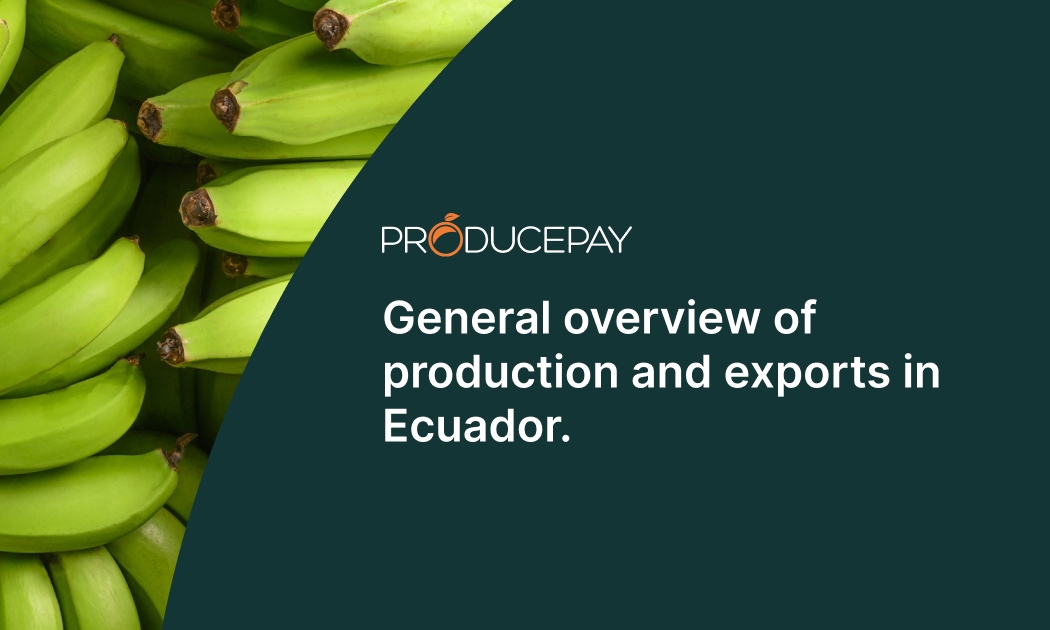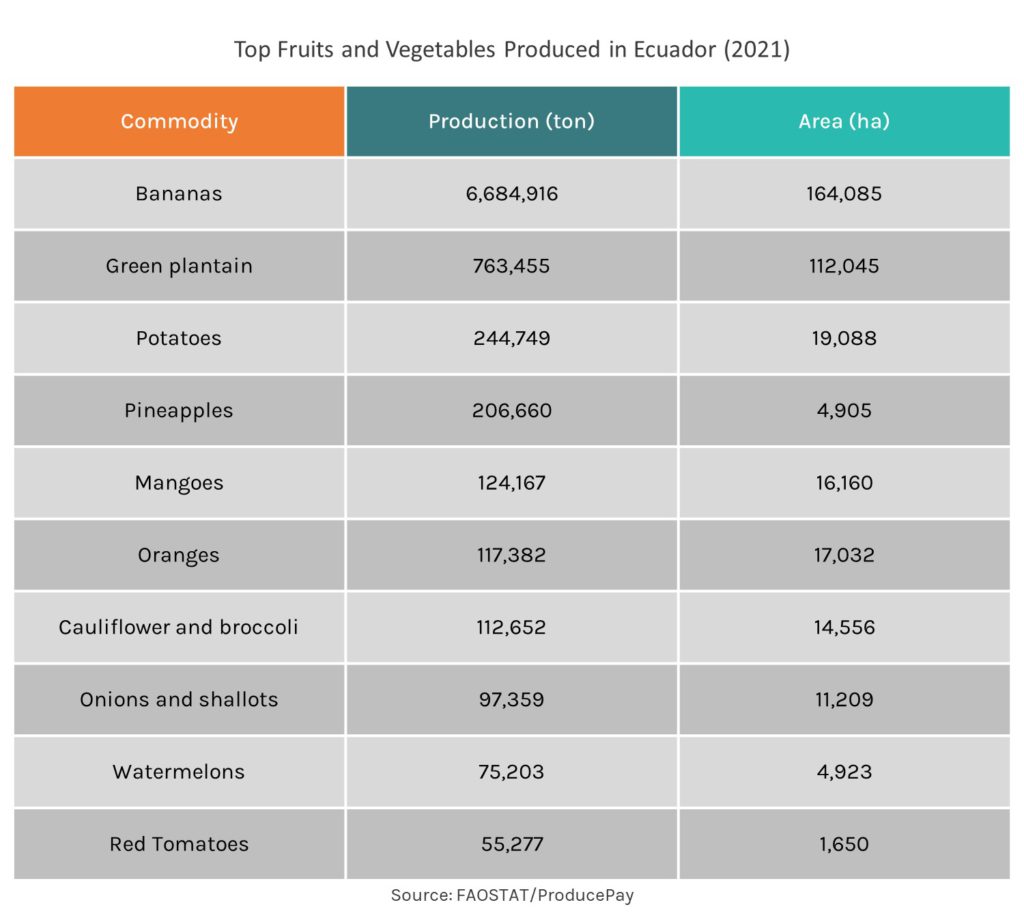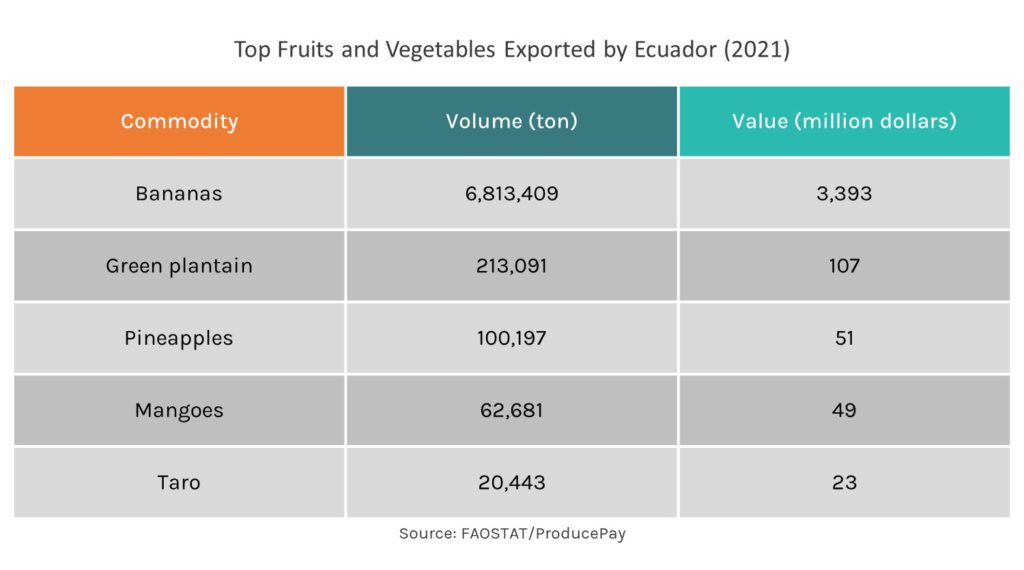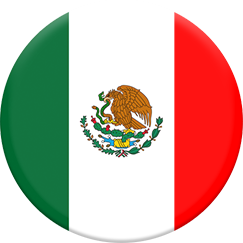
General overview of production and exports in Ecuador.
Ecuador is a major exporter of tropical produce. The nation’s diverse geography includes mountains, coastal plains and Amazonian regions, making it ideal for growing a wide range of crops.
Additionally, favorable trade agreements give Ecuadorian growers access to foreign export markets, which incentivizes them to diversify their products to meet global demand.
As one of the country’s largest employers, the agriculture sector is critical to the national economy and a significant contributor to GDP.
Ecuador’s most valuable produce
Ecuador’s geographic and climatic diversity makes it ideal for growing a wide variety of fruits and vegetables.
Its largest crops by volume are bananas, green plantains, potatoes, pineapples, mangoes, oranges, broccoli, cauliflower, onions, shallots, watermelons and tomatoes.
Growing occurs in different regions of the country, from the coast to the highlands and jungle, and each crop requires specific climatic and soil conditions for optimal growth and production.
Ecuador is one of the largest global exporters of bananas. The annual harvest represents 24.9% of national agricultural production, second only to sugarcane at 42.4%.
Green plantains are another essential crop. They’re an integral part of the national diet and a valuable export product. Potatoes are also a staple crop in the Ecuadorian diet and are grown in different varieties and altitudes, which allows for a wide selection of textures and flavors.
Pineapple and mango production has boomed in recent years due to high demand on the international market. Oranges are another vital crop, used mainly in producing juices and jams.
Due to a growing global demand for healthy foods, broccoli and cauliflower are valuable products in local and international markets.
Onion and shallots are consumed locally and exported to a lesser degree. Watermelon and tomatoes are produced mainly on the country’s coast, where climate and soil conditions favor optimal growth and production.
According to FAOSTAT, these ten horticultural products accounted for 31.6% of the total agricultural production in Ecuador in 2021, demonstrating the importance of these crops for the country’s economy, food supply, and international trade.
The labor required to maintain production is essential in generating employment in rural areas and improving the quality of life for farmers across the country.

In addition to the produce listed above, Ecuador also harvests over 10,000 tons annually of papaya, avocado, carrots, turnips, tangerines (mandarin, clementine), limes and lemons, green peas, melons, lettuce, chicory, and coconuts.
Primary Ecuadorian fruit and vegetable exports
In 2021, Ecuador’s top five horticultural exports were bananas, green plantains, pineapples, mangos and taro, which shows the importance of tropical produce for the country’s economy.
Bananas are Ecuador’s most important export crop, accounting for 82% of agri-food exports. The South American nation is one of the world’s leading producers and exporters of bananas, thanks to its favorable climatic and soil conditions for their cultivation.
Green plantains are another significant export product because of their high commercial value in the international market. Pineapples and mangoes have also experienced an increase in demand in recent years thanks to their flavor, quality and nutritional value.
Taro is a crop that has gained strength as an export product due to growing demand in countries in Asia and Oceania. It’s a plant that originated in Asia but has adapted to Ecuador’s soil and climate conditions, becoming an essential source of income for the country’s farmers.

Main destinations for Ecuadorian agro-exports
Currently, Russia is the leading buyer of Ecuador’s agro-exports in terms of volume. In 2021, they received 18.6% of Ecuadorian exports, equivalent to 1,171,923 metric tons.
However, if we consider the value of agro-exports, the United States ranks first, with a total import value of $1.596 billion in 2021. Russia is in second place at $827 million.
The United States, the Netherlands, Turkey and Germany collectively purchased 29.7% of the country’s total exports.
As for Latin American trade partners, Chile ranks sixth, receiving 4.1% of Ecuador’s exports, which translates into 339,193 tons and $193 million. Argentina is in eighth position, followed by Colombia in fifteenth place and Peru in twenty-sixth.
Critical challenges to Ecuador’s agribusiness exports
Growers and exporters of agricultural products in Ecuador face several challenges, including:
- International competition: Competition from other food-producing countries can make the prices of Ecuador’s agri-products less competitive on the global market.
- Limited infrastructure: Lack of adequate infrastructure in rural Ecuador limits growers’ ability to transport and store their products, which increases costs and reduces quality.
- Limited access to financing: Growers and exporters face difficulties obtaining funding to invest in the production, transportation, and export of their products, which limits their ability to grow.
- Regulatory standards: Compliance with domestic and international regulatory standards for food safety, quality and sanitation can increase production costs for agricultural products.
- Shortage of qualified labor: The lack of skilled workers in the agricultural sector limits the ability of growers to adopt new technologies and production techniques, which can negatively affect the quality and quantity of production.
Why is financing important for Ecuador’s agro-export sector?
- Ecuador’s agro-export sector is one of the pillars of the national economy, generating significant income and employment in rural areas. However, considerable infrastructure, technology, and training investment is required to achieve sustainable and competitive growth.
- Unexpected adverse situations can significantly impact their business, such as the Russian-Ukrainian war, which has negatively affected Ecuador’s banana exports.
- The conflict in Ukraine has resulted in a dramatic 99.2% drop in Ecuador’s banana exports to that country through February 2023. In addition, banana exports to Russia, Ecuador’s primary trading partner, are down 8.0% compared to last year.
However, the decline in banana exports is not only due to the situation in Ukraine and Russia. Ecuador’s total banana exports declined by 12.2% in 2022 compared to 2021 because of rising production costs from the coronavirus pandemic and global inflation.
Both growers and exporters must be prepared for unpredictable situations. That’s why they must take measures to diversify their markets and mitigate risks. Planning and adaptation are key to maintaining resilience and long-term sustainability for Ecuadorian growers in the banana export sector.
Sources: FAOSTAT, FATOSTAT, FreshPlaza, Fresh Plaza

